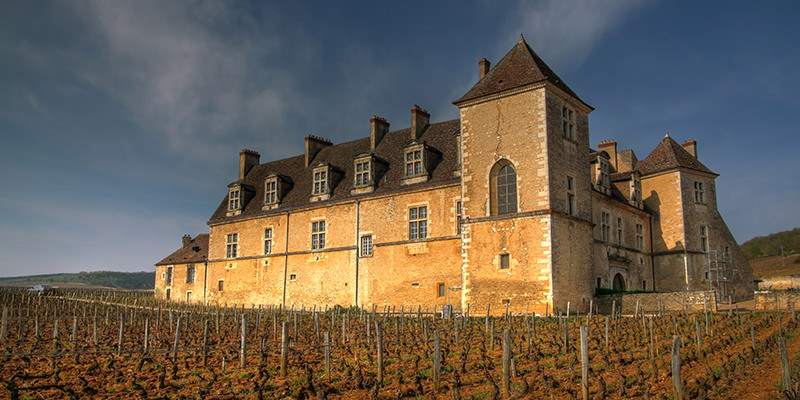For a grape that’s notoriously difficult to grow, Pinot Noir is ubiquitous in wine regions from its ancestral home in central France to mountainous Australian vineyards, and even hot California deserts where it doesn’t thrive. While Sideways may take credit for making this berry-scented red easy to sell, the world should thank Cisterican monks and ancient Popes over Paul Giamatti’s 2004 performance.
Before we get into the intricacies of Catholic orders, damnation to Gamay, and lots of brimstone, let’s focus on the Pinot Noir grape itself. The undisputed King of Burgundy, Pinot Noir has been documented in France since the Roman era, when these Italian conquerers spread across Europe leaving grapevines in their wake. Unlike Cabernet Sauvignon or Chardonnay, this thin-skinned red doesn’t chug along producing quaffable wines every vintage and in every climate. Instead, its cone-shaped bunches are prone to disease and rot — which can be brought on by both too much, and too little water. Like most vines, Pinot Noir requires lots of sunshine, but it withers in the high temperatures required for ripening other reds like Spanish superstars Grenache and Tempranillo. And while Pinot Noir can age for decades, slightly improper storage can turn expensive bottles to vinegar in just a few years.
So why the fuss? Heavenly Salvation, of course. Around the year 1,000 A.D., long after the Romans had abandoned their early vineyards in France, the Cistercian order of Monks began gaining authority outside the modern city of Dijon. In addition to vows of poverty and abstinence, these monks believed a devotion to hard labor brought them closer to god, and thus began cultivating the rocky hillsides of early Burgundy. Over hundreds of vintages, they painstakingly maintained detailed records of their vineyards — describing exactly how, and exactly where vines thrived or withered — and how the resulting wines tasted. In doing so, they created the world’s first harvest reposts and simultaneously invented the idea of terroir. These records, and the notion that wines reflect their growing locales, permanently shaped the wine biz by making terroir a critical concept and selling point.
Because Burgundy wasn’t on a major trade route, the Cistercian orders didn’t sell large volumes of wine like their neighbors in Bordeaux or the Loire Valley. Unlike the highly advertised wines of Champagne, the monks were driven toward high-quality wines by religious devotion, instead of monetary gain. Gamay, the other red grape of Burgundy, was outlawed in the region by Duke Phillipe in 1395, paving the way to make Pinot Noir the region’s official king. Along with zealous commitment to the land, these factors led Pinot Noir wines to be associated with both quality and scarcity.
The terroir concept really gained steam (and gave Burgundy its superiority complex) when Pope Urban V refused to return to Rome in the Middle Ages because (to paraphrase) “You can’t get wine like this in Italy.” Enough said.
Post-Prohibition, American vintners — now making wine for pleasure instead of sacramental necessity — took cues from their European brethren when planting new vineyards. In doing so, they continued to discover the variable nature of Pinot Noir across micro-climates, especially in California. At the same time, vintners began planting experimental Pinot Noir in Oregon, New Zealand, and even Australia.
Today, over 40 mutations of Pinot Noir exist, and they all taste different — and not always in a good way. The variation sparks passion in winemakers and drinkers (sometimes to the point of divorces) to create the pinnacle of Pinot Noir. From earth-scented bottlings with firm tannins, to intensely ripe and raspberry-fruited wines there seems to be a Pinot Noir for every palate and nearly every meal (whether you’re a Paleo devotee or raw vegan).
Unlike Merlot, the classically plummy and boring vinous antagonist of Sideways, Pinot Noir is anything but boring or predictable, with hues ranging from deep purple to soft crimson, which inspired many California vintners to ditch Merlot for its difficult cousin in past few decades. While it often doesn’t crush palates the way cult Napa Cabernets or First Growth Bordeaux might, Pinot Noir inspires poetic ramblings from wine novices and oenophiles alike, making it a consistent seller in wine shops and restaurants worldwide.
From its thrones in the cool, foggy vineyards of Sonoma and Oregon’s Willamette valley, and across the Southern Hemisphere in the mountains of New Zealand and Australia’s remote river valley, Pinot Noir is the vinous “one that got away,” and continues to get away from winemakers and drinkers, selling thousands more bottles every time.
Bottles to Try:
For appreciating Pinot’s Burgundian Roots, Domaine Trapet Pere et Fils 2013 Marsannay Rouge showcases classic dark berry flavors tinged with spice, rich French oak, and an everlasting finish. Enjoy over candlelight with good friends.
Love Block Pinot Noir 2012 from New Zealand’s Central Otago region, expresses the modern side of Pinot Noir with smokey candied cherry and red currant flavors. Perfect with grilled lamb.
For California enthusiasts, MacMurray Ranch 2013 Russian River Pinot Noir is a $20 bargain, with ripe raspberry fruit flavors tinged with vanilla and lavender. Girls’ night? Book club? Date night? This bottle fits the bill for any occasion.

